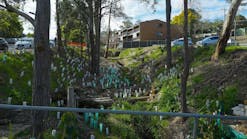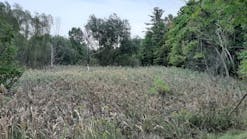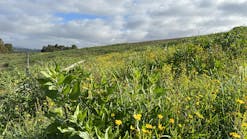It’s pretty obvious now. Nature didn’t intend for us to invade dry, barren tracts and fill them with millions of people. But that’s how things worked out, and today, long after the great southwestern desert cities have matured and long after we faced and conquered the technological challenge of supplying them with water and creature comforts, science is telling us that another huge environmental hurdle remains: the extremely unhealthy intensity of dust and sand. Fine particles of matter are blowing, swirling, settling, and being drawn into our lungs. Particles are being hurled into the breeze by every activity on the ground. In old western movies, posses gallop off across the sand, trailing a plume of dust-all very romantic and adventurous. But replace the posses with thousands of off-road enthusiasts in SUVs; think of incessant construction in American boomtowns; think of bulldozers, scrapers, front-end loaders, and backhoes tossing dirt around and sending it skyward; and the term of art is fugitive dust.Wherever this fugitive goes, it gets in someone else’s airspace. It settles in someone’s pool or someone’s lungs. The government is attempting to curtail the problem and enforce some control, but this part is not easy. Who kicked up this latest storm of particulate matter? How much should the perpetrator have to pay? How much of it meets a threshold to pose a health threat? Unlike human-made smokestack emissions, dust is quintessentially natural, ubiquitous, and constantly driven about by nature and by people. “Air,” concedes an expert in Texas charged with keeping it clean, “is extremely complicated.” Kevin Smith enforces dust control in the problematic environs of El Paso. “Even when you think you know the facts, you end up saying ‘Well, I only knew most of the facts,'” and it turns out there’s more to be explored, discovered, and evaluated. Smith and his scientific colleagues refer to themselves as “airheads”-their term of respect. Air is extremely complicated, and airborne dust is even more so because of air-quality standards and the dire health consequences of breathing organic dust. These intertwined issues make dust control politically difficult, contentious, and painful. This literally can be a life-and-death issue, and no one-shot inoculation or quick fix exists. Control measures must be effective. They must be modified to meet shifting conditions year by year. Dusty places are not necessarily consistent with each other, points out Charles Aldred of EPA’s Region 9 office in San Francisco, CA. “Some places have more wind. Some have more agriculture. Some have more unpaved roads.” Land topography, local commercial factors, the strains of rapid growth, population demographics, agricultural characteristics, water supplies, prevailing winds, local political values, and other issues come to bear on air, says Aldred, an environmental engineer in Region 9’s air-enforcement office (governing Arizona, California, Hawaii, and Nevada). The news isn’t all bad. Progress is being made in air-quality management practices, better dust suppressant formulas are on the market-“things that really work,” says Aldred. Ultimately both the definition of a dust problem and the prescribed solutions must be site-specific. As for enforcing the regimen that ensues, this too turns out to be tailored to each community, in a rapidly changing environment of new case law and legal theory. Killer Dust? Why It Is So Serious Wind-whipped dust is a visual annoyance-even a road hazard at times-but the core issue really is medical. Epidemiology and pulmonary research are heightening the level of urgency about desert dust and the need for its containment. According to Kevin Hamilton, the asthma program coordinator for Community Medical Center in Fresno, CA, and a member of Medical Advocates for Healthy Air (MAHA), studies show that particulate matter “causes reduced lung function; aggravates lung diseases, including asthma; slows normal lung development in all children under 14; and causes premature death. Particulate pollution is the most harmful form of air pollution to the human lung.” The Environmental Working Group, a public-interest watchdog group, claims that airborne soot and dust “cause or contribute to the deaths of more Californians than [do] traffic accidents, homicide, and AIDS combined.” This is claimed in statements posted on the Web site of Earthjustice, a California-based legal advocacy group. Earthjustice’s Vanessa Stewart explains that asthma cases in the state’s woefully dusty San Joaquin Valley region have reached pandemic proportions. “One in six children there suffers from asthma,” she says. This is double the national average. One in eight adults also gets asthma, and the number of severe asthmatic attacks leading to emergency-room admissions there is skyrocketing. Earthjustice and several other nonprofit organizations have filed multiple lawsuits against EPA and various air-quality authorities relating to the valley’s health crisis, hoping to raise public awareness and government response. In 2002, a multipage insert in The Fresno Bee explored health problems and air quality, after which, as Stewart recounts, air-quality concerns vaulted past every other social problem to become “the most serious topic of concern in California’s central valley.”The dust control challenge there stems largely from valley agriculture. The Clean Air Act (CAA) exempted farming from dust control rules because of political and economic implications. In this particular California garden spot measuring thousands of square miles, however, agriculture accounts for about 25% of the dust, and dirt roads specifically used by farmers (therefore also exempted) add another 25%, according to Earthjustice figures. In October 2003, EPA conditionally approved the San Joaquin Air Quality Management District’s (AQMD’s) latest dust control plans for nonagricultural sources, such as unpaved roads and construction work, but agriculture-accounting for half of the dust – still was exempted. EPA now is being sued for this decision by three groups: MAHA, Latino Issues Forum, and the Sierra Club. According to Stewart, newly revised plans for implementing dust control on valley agriculture now are imminent.Regarding San Joaquin, Aldred comments, “It’s just not politically feasible for us to be going out in fields and saying, ‘Your plowing is causing dust.'” San Joaquin poses, he believes, “a much tougher problem.” Construction Contractors Face Dust-Busting “Gestapo”Although San Joaquin is a worst-case example, it is not alone in the magnitude of its problem, nor are residents of other dust-ridden sites lacking in alarm and activism. Southern California (encompassing Los Angeles and the south-coast area to the Mojave Desert), Las Vegas and Reno, NV, Phoenix, AZ, and several other sites have been mobilized and traumatized about dust. High-population areas are home to hundreds of thousands if not millions of sufferers from asthma, valley fever, and other lung ailments either caused or exacerbated by fugitive dust. Meanwhile agriculture in these areas (also originally exempted) inevitably will be phased into legal oversight again; though good for sufferers, that will present an unprecedented challenge for communities politically, commercially, and administratively.Meanwhile dust control enforcement-in the form of fines, penalties, delays, and added labor expenses-is a new cost factor and sometimes a severe inconvenience to construction-and-demolition firms, landscapers, and highway road departments. One dust-suppressant vendor in California, who asks that his name not be used, reports, “Out here, local contractors refer to the air-quality board as ‘the Gestapo'” because local inspectors have the authority to close down work sites and often do. He adds, “Dust control is really necessary here, but it’s very, very stringent. We’re in a desert with a booming construction market. They [the air-quality district] will write you a ticket, and you have to cease construction for that day if you get a ticket. There are a lot of contractors complaining, but there are a lot more who’d rather have their local air-quality branch continue doing this than have the EPA come in. You don’t want the EPA to have an office in your city. And we’re on the verge of that here because we failed to make dust containment.”Of CAA, SIPs, and FIPs The terms failed containment and nonattainment refer to provisions in the 1971 CAA, as amended in 1990. Originally aimed at smokestacks and tailpipes, CAA actually monitors seven air categories, with particulate matter (PM) composing one subset. Airborne debris measuring 10 µm (the width of a human hair) or smaller is known as “PM 10.” When resulting from human activity and migrating away from private airspace, PM 10 becomes fugitive dust. A smaller particle size, PM 2.5, covers smoky and sooty exhaust. These two sizes, PM 10 and PM 2.5, respectively correspond to organic particles-of more concern for erosion control issues – and inorganic particles-of more concern to combustion producers. Both are likely to impact construction firms.
Earthbind 100 being applied with pressurized spreader bar CAA also mandates periodic scientific updating and so in the 1990s came the big push to control PM 10. Hundreds of state-run local and county AQMDs nationwide were required to submit cleanup goals or State Implementation Plans (SIPs) whenever EPA’s nearby monitoring stations determined high levels of PM 10. By 1993, AQMDs were required to implement “reasonably available control measures.” By 1997, they needed to be using the “best available control measures.”Aldred explains, “EPA doesn’t dictate day-to-day operations of [AQMDs] but leaves that up to states and counties,” which report to EPA via SIPs. Only when local efforts fail and nonattainment results does EPA take hands-on, direct control-referred to, in extreme cases, as getting “FIPped,” or being placed under a Federal Implementation Plan. Nonattaining counties also risk losing federal highway funds and being kept under federal watch for decades.The CAA amendments set the clock ticking in the 1990s, and EPA soon was eyeing areas lagging behind in meeting or attaining SIP goals. As of mid-2003, 55 multicounty areas were designated as “moderate nonattainment”; single counties in this predicament numbered 47. The total population impacted by both was 6.5 million people. In the category of “serious nonattainment,” eight desert areas and 17 counties, affecting 23 million inhabitants, found themselves under serious EPA scrutiny. EPA has FIPped only about a half-dozen jurisdictions in EPA Region 9 so far, says Aldred, beginning in the late 1990s. That extremity arises only after a half-dozen years of increasing PM 10 scrutiny. The vast majority of problem counties nationwide are concentrated in Region 9. For a look at what occurs when a city gets FIPped or nearly so, here’s how enforcement is being ratcheted up at several trouble spots.Maricopa County, ArizonaIf San Joaquin’s dust-up is made unusual by farming, Phoenix’s is rendered more problematic by its boomtown economy, high population, and environmentally severe conditions. In the late 1990s, EPA federalized Maricopa County, establishing a local EPA branch office and taking direct control. Aldred and others from Region 9 made frequent inspection trips there, issued notices of violations, and met with AQMD officials in often strained circumstances. “We were there,” says Aldred, “because we knew Maricopa County had a serious air-quality problem because of fugitive dust, and yet the resources that the county brought to the inspection and enforcement … we felt were nowhere near adequate for the magnitude of the problem.” EPA wanted to raise local consciousness “and kind of push the county” into making more vigorous efforts, he adds.EPA thus began imposing fines at an unprecedented level, penalizing violators between $10,000 and $30,000 per violation. During an ensuing 19-month period ending in 2002, federal and local inspectors from the Maricopa County Environmental Services Department completed nearly 10,000 dust inspections and collected about $620,000 in penalties. (Outside of Maricopa and two other FIPped Arizona counties, Pima and Pinal-where collectively about 85% of air-quality regulations occur-a total of $5,256,000 in civil penalties for air-quality violations has been collected since the start of 2000, according to Todd Mason, the Arizona Department of Environmental Quality Air Quality Division.) Today, says Aldred, “Maricopa County is exemplary-and doing a very good job. Violators get a lot of penalties. The county has a fair number of inspectors. It’s a large county and [AQMD] now has a strong presence,” offering dust control seminars for homebuilders and doing a good job at communicating and enforcing rules consistently.
Lou Snow of Phoenix-based Dust Pro Inc., which provides soil-stabilization services, brings a local and a personal perspective to Maricopa air quality: “I’m also a native and have valley fever and everything else from dust.” EPA’s extension to Phoenix, he says, has been extremely controversial and is criticizable on several counts. “There’s tremendous fragmentation between EPA and local and state government – big, big friction problems. EPA is ramming [its program] down their throats, telling Arizona, ‘You’ll do this now, our way.'” EPA’s way arguably relies too much, in Snow’s opinion, on city water supplies as a suppressant-“trillions of gallons, requiring high volumes, and repeat applications.” Alternative dust management practices, such as slowing down the pace of construction equipment and more selective targeting of dust problems, haven’t been given sufficient emphasis, he believes. Other proven nonwatery containment measures that he thinks should be used include using 4-ft.-high fabric fences around construction sites, disturbing only small areas and stabilizing one area before disturbing a new one, reseeding with native grasses, Xeriscaping, mulching, and surfacing with gravel. Some of the burdensome costs and disruptions in Phoenix perhaps have been unnecessary.
Agricultural road half-treated with Earthbind 100 Too, Snow says, EPA’s methods for determining violations leave a lot to be desired. No objective standard for quickly gauging fugitive dust has yet been developed. EPA’s complaint-driven enforcement poses some problems: Incoming calls are voluminous-ranging from the frivolous to the critical-and in either case inspectors often don’t show up until the mess is over. EPA’s assorted dust-quantity test methods, he finds, “are just antiquated, crude, and not really an accurate means of making a determination.” One such test involves dropping a ball and watching how much dust is kicked up. Another, called Method 9, requires inspectors to pass a course in which they observe a portable smoke-making machine emit various colors of smoke, which is meant to simulate dust. “This smoke has nothing to do with dust,” Snow says. “And yet we’re certifying inspectors nationwide based on a smoke-school test. It’s totally irrelevant.” Snow has contemplated approaching the American Society of Testing Methods to persuade them to devise a more scientific methodology. Aldred acknowledges some of these shortcomings but adds that unfortunately “we’re not yet to the point” where dust control can be subjected to wholly objective standards. “The good thing is that dust obviously is a very physical pollutant, and most reasonable people would agree when something is a problem. Anyone who sees a big cloud of dust that’s blowing onto a road or onto a property knows it’s a problem.” The colored smoke machine that Snow mentioned “was originally designed to simulate stationary sources like smokestack emissions,” Aldred concedes. “It doesn’t do a good job with a wide assortment” of real-world conditions, such as simulating ground-level dust. Clark County, NevadaLas Vegas matches up with Phoenix as a desert metropolis with a large population, a booming construction market, and a big, expensive struggle to overcome its status of serious nonattainment. As of December 2003, Clark County was expecting to have its PM 10 containment plan approved (although a previous plan was shot down in January). In any case, starting in 2004, EPA began measuring Las Vegas’s dust and will continue monitoring it through 2006. At that time, Clark County will face a witching hour. If the previous three-year averages still indicate nonattainment, the area probably will face EPA federalization and sanctions similar to those applied in Phoenix.As a starting point in its containment battle, in the late 1990s the local AQMD was moved from state control to local control, enabling Clark County to underwrite the cost of more than doubling its field inspectors to its current 16. At about the same time, dust-monitoring stations determined that construction activity was responsible for nearly 40% of area fugitive dust, and AQMD targeted builders. This effort has resulted, says Ron Smolinski of Clark County’s air-quality information department, in the county developing “probably the stiffest regulations on construction in the country”:During the permitting process, builders must get approval for their dust-abatement plans before they dig. Every year, 2,0003,000 permits are issued, and about 7,0008,000 site inspections take place.At sites larger than 50 ac., full-time dust monitors must be present.Stiffer rules, fines, and penalties have been imposed. The ticket for a fugitive-dust first offense was raised to $2,000, but, notes Smolinski, “We routinely levy some $20,000, $30,000, and $40,000 fines for some larger facilities that refuse to get into compliance.” In the first 10 months of 2003, Clark County collected a total of $356,920 in dust fines (all funneled into local schools).A dust control education and communications program was launched, giving earthmoving contractors and crews continuing seminars and how-to tips. Whenever winds in excess of 25 mph are forecast, the county faxes an alert to 1,200 local builders, advising them of precautions to take.Builders can get referrals on approved dust-suppression products from the Conservation District of Southern Nevada.As a result, in 2001 monitoring showed that construction dust had fallen from its previous 40% share to about 25% of the total. It’s still improving, despite a torrid building pace.Now Clark County’s focus has shifted to a potentially thornier source of flying dust-citizens’ use or misuse of vacant land. This, says Smolinski, encompasses the activities of millions of people: “all of the soccer moms taking shortcuts off the main road” and recreational land use of all kinds-trail bikes, all-terrain vehicles, and the like. Policing this activity is impossible, so the county recently launched a public awareness program with the catchy billboard slogan “Don’t be a Dusthole!” Along with raising public awareness, the county has issued tough restrictions on using vacant lots, driving on road shoulders, and doing virtually any activity that can kick up dust, including even the county’s own roadwork. High-volume gravel roads (those getting 150-plus vehicle-miles-traveled) all will be paved. And in 2003, a 24-hour dust complaint hotline (702/385-DUST) was implemented. It’s receiving more than 100 calls a month, and “every complaint is investigated,” Smolinski notes.Whether these measures will suffice to prevent Las Vegas from getting FIPped still is up in the air. “We’re doing everything proactive we can think of” to avoid it, Smolinski says, such as looking for more innovative dust solutions, “because we don’t want EPA to come here and set up shop. We love them but not that much.”El Paso, Texas“As a whole, the State of Texas is not too concerned” about EPA taking over air quality, says Smith, air-section manager for the Texas Commission of Environmental Quality (TCEQ) for El Paso. Texas has, he says, a “very stringent and well-established enforcement program” conceived by TCEQ. The state’s only nonattainment area is his district, which, he says, “is technically if not legally no longer in nonattainment.” El Paso is getting a grace period from EPA, thanks to recent monitoring data. Another critical factor in EPA’s lenient assessment was the discovery that much of El Paso’s fugitive dust problem has been migrating across the US-Mexico border from nearby Juarez.El Paso was never classified as a serious nonattainment area, but it has been under a close watch. TECQ implemented its SIP there more than 10 years ago. The relatively moderate mandates included paving of more roads and requiring trucks and railcars to have covers over loads of dirt and debris. Penalties for failing to do the latter are in the wrist-slap neighborhood of $500, “but they do occur fairly often,” Smith notes. A newer fugitive-dust rule, 111.145, applies to construction-and-demolition contractors clearing 1 ac. or more of land or working on streets, alleys, and parking lots. Crews must apply water and/or suitable dust-suppression products, enclose any sandblasting site, and lay down asphalt or other dust-suppression measures on construction access roads. Enforcement of 111.145 has been, Smith concedes, “somewhat less than vigorous,” but he anticipates stepping it up soon, for fairness and consistency. In addition, even though his district is now technically in containment, he says, “We get a lot of really dusty days here, and it’s being noticed.” Enforcement will continue, if not increase.Coming to Your Town Soon?One overall impression about local enforcement activity (based on more than a dozen calls to normal-moisture areas in the North, the South, and the East) is that, apart from AQMDs responding to occasional citizen complaints, little aggressive enforcement is occurring east of the Rockies because little or no pressure for it exists. In fact, quite to the contrary, certain business-friendly local governments seem wholly content with laissez faire and don’t relish the prospect of imposing on building contractors. Normal rainfall, humid air, and fresh morning dew still are, after all, the most effective natural dust suppressants. EPA’s monitoring stations still will trigger an enforcement scramble wherever needed. In addition, any future enforcement likely will be more measured than that in Phoenix because containment methods developed in the West are improving with practice and can be adapted and scaled more readily to other settings. Whenever EPA does come knocking, the first step for a targeted community likely will be some kind of announcement by the local AQMD managers that, henceforth, residents, contractors, and government services causing dust will have to pay hefty permit fees for the privilege of filing and review and potentially high penalties for subsequent violations. Per-acre assessments likely will be imposed; however, fees might be scaled back or even rebated, depending on the success of control efforts. Resulting monies likely will pay salaries for more inspectors, more dust control education programs, and more paving or sealing of local dirt roads. The sequence described above actually occurred in the late fall of 2003 in Bernalillo County (Santa Fe), NM, after EPA determined that local dust was creeping above acceptable levels.If you’re concerned about enforcement in a given area, you easily can track the monitoring station data yourself by visiting EPA’s AirData Web database. Area and county emissions reports, maps of nonattainment areas, monitoring-station trends, summaries, and other data are available by querying the site at epa.gov/air/data/. A similar privately funded Web site by a scientific group called creativemethods.com crunches older EPA data into “air quality report cards.” These assign grades from A to F for PM 10 and other air pollutants, county by county and state by state. A third potentially useful and searchable Web database is EPA’s Enforcement and Compliance History Online at epa.gov/echo. It’s a catalog of all violations, infractions, inspection reports, and enforcement actions occurring at 800,000 facilities nationwide. You can search for dust events by area codes or other means to learn what occurred and who got stung for how much.EPA’s Aldred sums up: “The real message is ‘Get to know your local air district.’ Don’t just give them one call and figure that suffices. If you’re a contractor and you’re encountering problems, ask them for advice. They may have seen something work in another site you haven’t seen yet. Or maybe they will be a good source for [dust-suppressant] product referrals.” Ideally EPA’s air-quality enforcement also will produce in communities “a kind of culture and awareness” in which dust-containment practices “become integrated into daily construction practices,” he says. Maintaining healthy air shouldn’t be regarded as primarily a legal obligation but rather as a cherished civic value.





